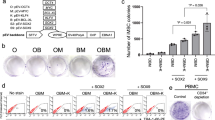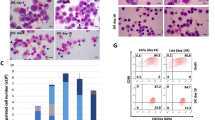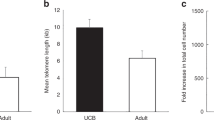Abstract
Induced pluripotent stem cells (iPSC) provide an invaluable resource for regenerative medicine as they allow the generation of patient-specific progenitors with potential value for cell therapy. However, in many instances, an off-the-shelf approach is desirable, such as for cell therapy of acute conditions or when the patient's somatic cells are altered as a consequence of a chronic disease or aging. Cord blood (CB) stem cells appear ideally suited for this purpose as they are young cells expected to carry minimal somatic mutations and possess the immunological immaturity of newborn cells; additionally, several hundred thousand immunotyped CB units are readily available through a worldwide network of CB banks. Here we present a detailed protocol for the derivation of CB stem cells and how they can be reprogrammed to pluripotency by retroviral transduction with only two factors (OCT4 and SOX2) in 2 weeks and without the need for additional chemical compounds.
This is a preview of subscription content, access via your institution
Access options
Subscribe to this journal
Receive 12 print issues and online access
$259.00 per year
only $21.58 per issue
Buy this article
- Purchase on Springer Link
- Instant access to full article PDF
Prices may be subject to local taxes which are calculated during checkout






Similar content being viewed by others
References
Takahashi, K. et al. Induction of pluripotent stem cells from adult human fibroblasts by defined factors. Cell 131, 861–872 (2007).
Aasen, T. et al. Efficient and rapid generation of induced pluripotent stem cells from human keratinocytes. Nat. Biotechnol. 26, 1276–1284 (2008).
Kim, J.B. et al. Direct reprogramming of human neural stem cells by OCT4. Nature 461, 649–643 (2009).
Loh, Y.H. et al. Generation of induced pluripotent stem cells from human blood. Blood 113, 5476–5479 (2009).
Ye, Z. et al. Human induced pluripotent stem cells from blood cells of healthy donors and patients with acquired blood disorders. Blood 24, 5473–5480 (2009).
Haase, A. et al. Generation of induced pluripotent stem cells from human cord blood. Cell Stem Cell 5, 434–441 (2009).
Eminli, S., Utikal, J., Arnold, K., Jaenisch, R. & Hochedlinger, K. Reprogramming of neural progenitor cells into induced pluripotent stem cells in the absence of exogenous Sox2 expression. Stem Cells 26, 2467–2474 (2008).
Kim, J.B. et al. Pluripotent stem cells induced from adult neural stem cells by reprogramming with two factors. Nature 454, 646–650 (2008).
Anderlini, P. Effects and safety of granulocyte colony-stimulating factor in healthy volunteers. Curr. Opin. Hematol. 16, 35–40 (2009).
Gluckman, E. History of cord blood transplantation. Bone Marrow Transplant. 44, 621–626 (2009).
Gluckman, E. & Rocha, V. Cord blood transplantation: state of the art. Haematologica 94, 451–454 (2009).
Giorgetti, A. et al. Generation of induced pluripotent stem cells from human cord blood using OCT4 and SOX2. Cell Stem Cell 5, 353–357 (2009).
Acknowledgements
We thank Dr. M. Torrabadella, Director of the Banc de Sang i Teixits, Vall d'Hebron for providing cord blood units. We are grateful to Y. Muñoz Santos for expert assistance with cell culture techniques. N.M. was partially supported by the Juan de la Cierva program. This work was partially supported by grants from MICINN, CIBER, the Fondo de Investigaciones Sanitarias (RETIC-RD06/0010/0016), TERCEL, the G. Harold and Leila Y. Mathers Charitable Foundation and Fundación Cellex.
Author information
Authors and Affiliations
Contributions
A.G.: protocol design, isolation of CB CD133+ cells, generation of iPS cell lines and preparation of manuscript; N.M.: protocol design, isolation of CB CD133+ cells, generation of iPS cell lines and preparation of manuscript; I.R.-P.: characterization of iPS cell lines; C.A.: characterization, selection and provision of CB units; A.V.: preparation of manuscript; and J.C.I.B.: preparation of manuscript.
Corresponding author
Rights and permissions
About this article
Cite this article
Giorgetti, A., Montserrat, N., Rodriguez-Piza, I. et al. Generation of induced pluripotent stem cells from human cord blood cells with only two factors: Oct4 and Sox2. Nat Protoc 5, 811–820 (2010). https://doi.org/10.1038/nprot.2010.16
Published:
Issue Date:
DOI: https://doi.org/10.1038/nprot.2010.16
This article is cited by
-
EpEX/EpCAM and Oct4 or Klf4 alone are sufficient to generate induced pluripotent stem cells through STAT3 and HIF2α
Scientific Reports (2017)
-
Current status in cancer cell reprogramming and its clinical implications
Journal of Cancer Research and Clinical Oncology (2017)
-
Looking to the future following 10 years of induced pluripotent stem cell technologies
Nature Protocols (2016)
-
Bovine male germline stem-like cells cultured in serum- and feeder-free medium
Cytotechnology (2016)
-
An Overview on Human Umbilical Cord Blood Stem Cell-Based Alternative In Vitro Models for Developmental Neurotoxicity Assessment
Molecular Neurobiology (2016)
Comments
By submitting a comment you agree to abide by our Terms and Community Guidelines. If you find something abusive or that does not comply with our terms or guidelines please flag it as inappropriate.



